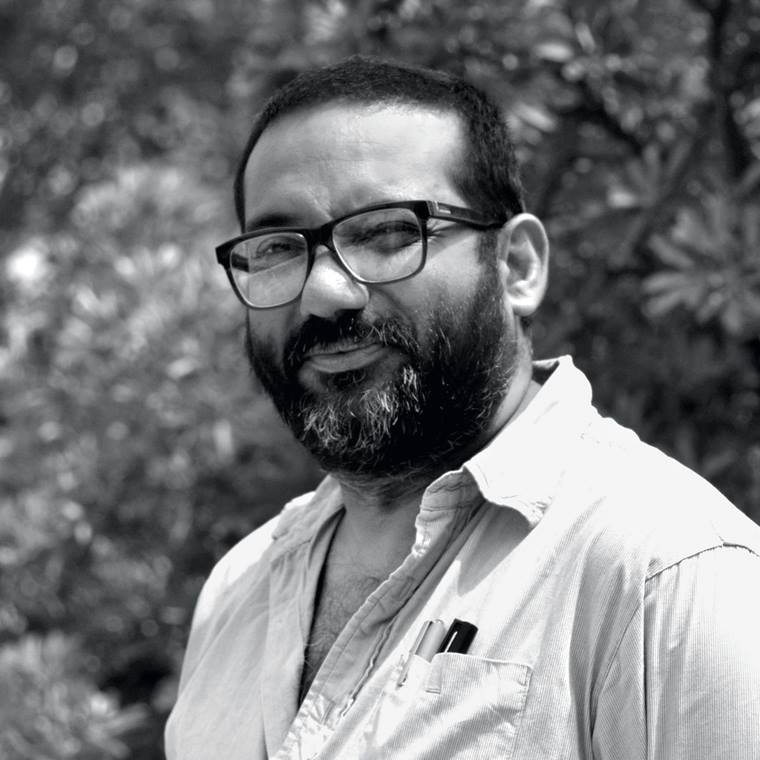K.H. Ara was one of the artists from the renowned artist group Progressive Artists’ Group of Bombay. One of the founders of the Artists’ Centre in Mumbai. He was one of the first contemporary Indian painters to meticulously use the female nude as a subject. He hosted his first solo show in the Chetana restaurant in Bombay in 1942 which was a runaway hit. Since then he did some group shows with progressive artists’ group members.
Born in Bolarum, Secunderabad April 1914, his childhood was hard. His father was a chauffeur and his mother died when he was 3 years old and his father remarried. When he was seven he ran away from home to Mumbai, where he lived all his life. Ara participated in the salt satyagraha during the Civil Disobedience Movement and was jailed for five months. He late founded employment with a Japanese firm as a car cleaner and later found employment as a houseboy in an English family. Although he was employed full time he got a lot of time to engage with his passion for painting and soon caught the attention of first Rudy von Leyden, an art critic from the Times of India, and Walter Langhammer, the Editor of Illustrated Weekly of India. Langhammer was so impressed by Ara’s skill that had him enrolled at the J.J. School of Art.
Later, on India’s independence, he created a large canvas depicting an Independence Day procession of a multitude of Indian people in exuberant celebrations.
Career as an artist
In 1942 he hosted his first solo show in the Chetna restaurant in Mumbai. This solo show was a moderate success. In 1948, the year India gets independence and progressive artist group was formed and Ara was one of the founding members of the group. He collaborated with FN Souza, SH Raza, MF Husain, Sadanand Bakre, H.A. Gade for the many group shows in Bombay, Calcutta, Bengaluru, and Delhi.
Progressive artists’ group set up their artist center at Kala Ghoda, opposite Chhatrapati Shivaji Maharaj Vastu Sangrahalaya. From 1948 to 1955, Ara held several solo and group shows in Mumbai, Ahmedabad, Baroda, and Calcutta and later had solo exhibitions across Eastern Europe, Japan, Germany, and Russia.
In 1963 he exhibited his “Black Nude” series in Mumbai and was part of the inaugural show at the Pundole Art Gallery. The Kumar gallery of New Delhi has acquired most of his works between 1955 to 1960.
Style of works
KH Ara is best known for his nude and still life paintings although he started his career as a landscape on the socio-historical theme. He was one of the first Indian artists who used the female nude as a subject under the limits of naturalism. Many of his works deal with still life as well as human figures studies.
At the starting of his career, he used gouaches and watercolor as a medium but later in life he decided to use oil colors. His works are available in all forms of paints i.e. watercolors, Gouaches, and Oil. His painting “Woman with Flowers” is one of the most famous of all his works. In his works, we can easily see the deep influence of French artist Cezanne.
Awards and recognition and Criticism
Ara won Governor’s Award for painting in 1944 and a gold medal from the Bombay art society for his canvas “Two Jugs” In 1952. He also won the Windsor and Newton cash price, Bombay. There are some art critics who criticize his paintings and accused him of executing them poorly as well as say that his paintings are not referenced from real life. Some critics also say that his still life paintings have more voluptuousness than his nude paintings. It is only critics’ opinion but in the 21st century, he got more than ever fame for his works and some critical success for being ahead of his time.
Later life and death
He remained asexual and bachelor for his whole life and later adopted a daughter Roxana Pathan. Later in his career, he started exhibiting less and spending time in Artists’ Centre. In Artists’ Centre, he often helped budding artists financially and artistically. He moved away from the fame he got in the early 1960s and 1950s. Unlike other progressive group members, he spent most of his time in India. He was part of the managing committee of the Bombay Art Society and later became the fellow of Lalit Kala Akademi. He died in 1985 in Mumbai at the age of 71.
Influence on the Indian art
It is crucial and very important to note that the PAG was one of the most sought-after Groups of our modern Indian in the Indian art society and as a member of PAG Ara was extremely influential in his own territory. It doesn’t matter that he has been able to put the same influence on the world in art as much as his colleagues or not but there is a certainty that he became a better artist with time as well as a minimalist in his own term with a good heart who help other artists more openly and dearly than the others. His growth was not only for his personnel perspectives but for also the young talents rising in his time and came into his contact. He plays the role of an artist more effectively and humanitarian with more accuracy. He was indeed an amazing member of the group and probably the heart of the group with his core values and artistic endeavor.

Vikash Kalra is a self-taught artist and writer based in New Delhi whose work has been exhibited across India and is held in several private and corporate collections.